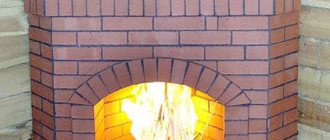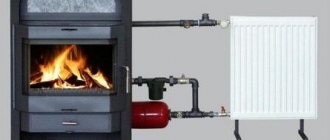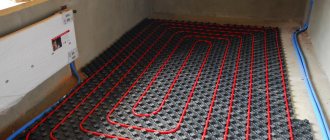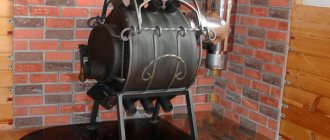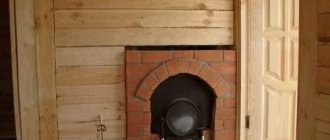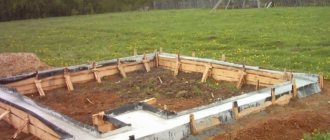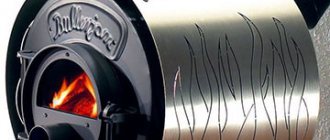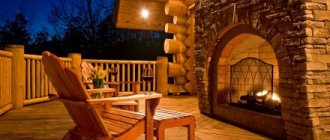A brick fireplace is the main detail in the house, definitely associated with comfort. A living fire warms just by its appearance. But in practice, the efficiency of this device is no more than 50%, so many owners install a metal fireplace with a water heating circuit in their home in order to increase the efficiency and heat the entire home. It is easy to make such an interior element with your own hands if you comply with the technical requirements and strictly follow the installation instructions.
Operating principle of fireplace stoves
Fireplace stoves with a water circuit are used to heat private homes. Their main feature is their ease of use and high level of safety, despite the use of wood fuel. Moreover, these devices can be very attractive from an aesthetic point of view, both in the original metal case and in the finishing made of brick or stone.
This unit is a cast iron or steel chamber with thick walls:
- 4 mm – open model;
- 6 mm – closed version.
The design also has a heat exchanger, inside which the coolant moves. Pipes leading water from the heat exchanger deliver it to the batteries. There are air channels between the walls of the fireplace that support the combustion process, providing oxygen access inside the firebox either naturally or manually.
Once inside, the air heats up, passes through the air ducts and heats the room in which the fireplace is located. And hot water, heated in the heat exchanger, circulates through the pipes into the radiators and heats the entire house. Part of the hot water is used by the system for active operation.
The unit can be lined with a variety of materials, creating an attractive appearance of the device with your own hands. The outside of a standard purchased fireplace is covered with fireproof paint, and the inside is covered with heat-resistant tiles. Often the design includes a hob that allows cooking.
Possibility of using a fireplace-stove with a water circuit
A fireplace with a water heating circuit is used both as a backup and as the main source of heating the room.
In a situation in which a wood-burning fireplace with a water heating circuit is the main source of heating, a special connection scheme is created in which not only the heating of the house with a total area of up to four hundred square meters is carried out, but also the heating of water for everyday needs or the operation of the “warm floor” system .
But often a fireplace with a water jacket is connected to an already functioning heating system in the form of an alternative or backup heating source. By the way, when the fireplace is operating, the main heating system of the house is automatically turned off electronically, since special devices monitor the temperature of the water in the heating system, so you don’t have to worry that fuel will be used irrationally.
Water circuit
Any fireplace with a water jacket can be used without heating tasks, which becomes relevant on warm days. However, even in the warm season, the system can be used to heat water, since the need for hot water does not disappear in the summer.
Fireplaces with a water circuit can simultaneously solve a group of problems:
- , serious savings in energy resources will be achieved through the use of heat that previously simply flew down the drain.
- The traditional appearance of the fireplace is preserved, as is the opportunity to observe a live fire, at the same time it performs purely pragmatic tasks of heating the house and heating water. That is, the installation of this equipment allows you to combine business with pleasure. Family members have the opportunity to spend time by the fireplace, admiring the live fire, and heated coolant is supplied to the heating system of the house, which allows creating comfortable conditions in all rooms, and not just in the room where the fireplace is installed.
- A water fireplace will not require any unusual fuel sources . Most often, there are models that burn wood, but you can also purchase a pellet fireplace with a water circuit. This installation is heated with pressed sawdust.
Basic elements and connection diagrams
The components of a traditional metal fireplace, which you can assemble with your own hands, are very simple:
- circulation pump;
- heat exchanger;
- water tank;
- heating radiators;
- hydraulic accumulator;
- coolant temperature sensors;
- three-position tap.
The heat exchanger performs the function of a general structural element. It is located in the firebox, coolant is supplied to it from the expansion tank, and from it, using a circulation pump, water is delivered to the batteries. The hydroaccumulator is connected to heating radiators, but as close as possible to the metal stove.
Diagram of a fireplace with a closed water circuit:
The hydraulic tank is installed parallel to the heating system. You can close it with a special three-position tap. A circulation pump is mounted in front of the hydraulic accumulator, which ensures the movement of the coolant along the heating line.
Before turning on the unit, you must make sure that the water circuit is connected to the device and the system is filled with coolant, so as not to damage the structure of the device.
Important: The amount of water in the system directly depends on the area of the heated room and the number of circuits. A double-circuit system requires a doubling of the coolant volume compared to a single-circuit wiring.
A closed heating system differs from an open one in that in the second case a pump is not used to supply water to the device. The coolant enters the heat exchanger naturally under the influence of gravity. That is why the expansion tank should be installed at the highest point in the house, for example, in the attic.
Connection diagrams
Water heating circuit
To install such a structure in a two-story house with a usable area of 250 square meters, you need to adhere to the following placement of the fireplace:
- The structure is installed below, that is, on the ground floor
- The water tank is located in the technical rooms, this is where the heat from the coolant should flow
- In the container, the water is heated by a coil to the desired temperature.
- From the hydraulic accumulator (water tank), the heated water is supplied to the radiators
- With good design power, part of the heated water can be used for household needs
- The cooled water returns to the tank through the return line, heats up and again enters the batteries. The pipe circulates water intended for the personal use of the inhabitants of the house. That is, it also periodically heats up.
The diagram for installing a fireplace in an ordinary house (1 floor) does not differ significantly. The difference lies in the layout of pipelines, radiators and hot water supply. Although there are no significant differences in the installation of such stoves, some nuances are still worth considering. This is mainly due to the type and location of the expansion tank. Because of this, this design is divided into a closed connection method and an open one.
Open connection method
In this system, I install the tank at the highest point of the monastery (attic), where the water actually flows. Then it flows by gravity into the batteries. The system is characterized by ease of installation and the complete absence of additional electrical appliances.
Closed connection method
In this version, the water no longer moves by gravity into the tank, but with the help of a pump. You can install it anywhere, height and distance do not matter. This method has some advantages over the previous one:
- There are no restrictions on the area of the monastery for heating. That is, you can heat a house with a living area of more than 100 square meters (the previous connection method has such restrictions)
- The number of radiators can be increased without reducing the efficiency
- The system does not overheat
Advantages and disadvantages of the system
The fireplace stove combines the positive properties of these heating devices, while it does not have their inherent disadvantages.
What are the main differences between a conventional brick fireplace and a device with a water circuit?
- A stove with a water circuit heats up for a long time, but it accumulates heat and radiates it from the walls of the fireplace for a long time. An ordinary fireplace heats up quickly, filling the room with warmth, but quickly cools down and the temperature in the room drops.
- A water fireplace door that covers the entrance to the firebox improves draft and reduces the likelihood of smoke. The open firebox of a conventional fireplace provokes reverse draft and does not protect against smoke entering the premises.
- The efficiency of a system with a water circuit reaches 70-80%, while for traditional fireplace devices it is no more than 50%.
As a result, modern fireplace stoves have a whole list of positive characteristics:
- high efficiency - up to 90%;
- a firebox with a large sealed glass on the door allows you to look at the flames, but at the same time does not allow the room to smoke;
- the presence of smoke channels improves heat collection and transfer;
- beautiful appearance of the heating equipment housing;
- fire safety;
- light weight, thanks to which these units can be installed without a foundation, even on a wooden floor;
- relatively small size;
- environmental friendliness;
- the ability to connect a water heating system, which allows you to heat the entire house;
- relatively low price compared to building a traditional brick fireplace;
- durability of the structure;
- simple and quick installation that can be easily done with your own hands.
In addition, modern models of these units are equipped with many additional useful options. For example, a glass cleaning system, a hob, a long-burning mode.
However, during operation it became clear that fireplaces with water heating also have disadvantages:
- High cost compared to an electric boiler.
- Low level of automation.
- Low efficiency compared to a gas boiler.
But if you slightly improve the design of the heating device with your own hands, correctly calculate the required length of the tubes, and choose the right battery material, you can significantly save fuel consumption.
Water fireplace design
From a technical point of view, a fireplace stove with a water heating circuit is a metal firebox, where the wall thickness is from four to six millimeters (the first indicator is typical for open fireplaces, and the second for closed fireplaces).
Photo 1. Water fireplace
The heat exchanger tubes are located between the walls of the firebox. Most often, the coolant system contains about forty liters of water circulating through the heat exchanger tubes and heating up due to the energy that is released during fuel combustion.
To drain heated water into the heating system, into heated floors or for domestic needs, the necessary elements of the pipeline system are connected to the coolant, as well as temperature sensors responsible for regulating the water supply.
On the outside, the design is complemented by a fireplace portal in a variety of styles, which makes it possible to fit the fireplace into any interior (see Decorative fireplaces in the interior). The power of the fireplace is controlled manually by regulating the air flow into the firebox.
Advantages of a water-type fireplace
Modern water-based fireplace stoves offer multiple benefits, including:
- the relatively low cost of water fireplaces in comparison with other types of boilers;
- Fireplace stoves with water heating are compatible with other types of heating systems that are already installed in the home. This installation is advantageous to use as a backup source of heating in houses where automatic boilers are used, that is, boilers running on gas, electricity or diesel fuel. It is irrational to use solid fuel boilers complete with a fireplace stove with a water jacket;
- use of inexpensive and accessible fuels for heating;
- a heating system using a fireplace makes it possible not only to heat large rooms, but also to preserve the style of the interior;
- A fireplace stove with a water circuit can be installed in different rooms, and the main requirement for them is fire safety. In addition, you should not install a fireplace in a children's room;
- no additional expenditure of electrical energy is required, the circulation of the energy carrier is carried out using natural processes of physics;
- water fireplaces are completely autonomous and easy to use;
- The fireplace can be lined with a variety of materials, which will harmoniously fit the design into any interior. So, if the decor is in a classic style, you can decorate the fireplace with polyurethane stucco. For rooms decorated in country style, it would be ideal to use tiles or facing bricks.
Disadvantages of a water-type fireplace
Despite many advantages, there are some issues that cannot be resolved with fireplaces of this type.
- The heating circuits in such systems do not have sufficient efficiency , and therefore it is not recommended to use fireplaces with a water circuit in very cold climates. In such a situation, a combination of several types of heating systems will be required. At the same time, even if a water fireplace is used only as an additional factor for heating the room, about forty percent savings in fuel are achieved, which is consumed for the operation of the main system.
- Insufficient automation. To start the heating system you will need to light a fireplace. However, if it acts as an additional heating system, this point is not critical.
Additional benefits of water fireplaces
Photo 2. Water fireplace
In addition to the basic functions related to heating properties, water fireplaces have a number of additional characteristics. For example, if the consumer wishes, the fireplace can be equipped with a stainless steel grill, as well as a set of devices for cooking food on the grill.
Such options not only make it possible to enjoy a live fire alone or with your family, heat your home and warm water, but also cook delicious dishes. For those who want to enjoy the fire in the fireplace, various solutions are provided in the form of transparent spherical screens or side glass inserts.
In addition to conventional water fireplaces, fireplaces of a combined type have been developed, which, using the heat of the chimney, are capable of heating the air. These air-heated fireplaces allow you to achieve more than twenty percent fuel savings compared to conventional fireplaces.
Nuances of choosing a device
When choosing the equipment in question, it is necessary to take into account two important points - the power of the device and the metal of manufacture.
The power of such a fireplace depends on the volume of the combustion chamber: the more fuel it holds, the more heat it releases to heat the building. At the same time, the documentation for the unit indicates the rated and maximum power of the device. So, the device should be used exactly at its rated power, without using it at maximum parameters, so as not to reduce the working life of the fireplace stove.
When choosing a device based on power, you should take into account the area of the structure. To the calculation performed, you need to add 15-20% of the technical reserve. A heating system with a fireplace and a water circuit must be distributed very correctly so that the heat is distributed evenly throughout all rooms.
Fireplace stoves for home heating are made of cast iron or steel. Cast iron models are more durable, resistant to corrosion processes, and therefore more expensive, however, such fireplaces are very heavy, and can crack due to sudden temperature changes. Stoves made of steel are lighter and cheaper, but are not corrosion resistant.
Therefore, the best option is a combined fireplace with a body and elements that heat up slightly, made of steel, and the firebox, door and grate, which heat up very strongly, are made of hardened cast iron.
Such furnaces are able to withstand high temperatures for a long time and are resistant to condensation that forms in the pipes. Therefore, combined models are ideal for long-term use as a heating device.
Furnace construction stages
It is convenient when, at the time of building the furnace, the heat exchanger is already welded to the heating system. You won’t have to figure out how to secure the structure while construction is underway; all distances will be precisely verified. How to do it:
- The foundation is being poured.
- Waterproofing is being done.
- The first rows are laid out dry, that is, without solution, up to the level where the heat exchanger will be installed.
- The amount is added to the seams (0.5 cm per row). The heat exchanger is placed on supports, for example, wooden blocks, with a height equal to the total thickness of the joints.
- Welding work is carried out - the supply and return pipes are connected.
- The bricks are removed, the heat exchanger remains hanging on the pipes.
- Laying on mortar is carried out.
Particular difficulties arise when constructing where the register bends. Each brick here needs to be cut, precisely adjusted to the size and shape of the heat exchanger, taking into account the gap.
Where the pipes emerge from the masonry, a small gap is also left, which will be covered with clay during plastering work.
Need to heat a large house? Long-burning stoves with a water circuit are an ideal option for heating a large room.
Instructions for making an exhaust furnace with a water circuit are presented on this page.
How to build with your own hands?
There are quite a lot of offers on the modern market of such equipment. The cost of a unit with a capacity of 14 kW for heating housing with an area of no more than 140 sq.m. starts from 23,000 rubles. A device with a higher power of 26 kW for heating a home of 200 sq.m. and more starts at 230,000 rubles. To save money, you can make a fireplace with water heating yourself.
You can make the stove body yourself from natural stone or brick, and if you have welding skills, you can weld such a fireplace from metal sheets yourself. In any case, before starting work on arranging a fireplace stove, it is necessary to study the standard design of this unit, as well as the basics of stone or brick laying.
After this, you can begin building a fireplace with a water circuit:
- First you need to lay a solid foundation, reinforced with a reinforcing belt. In this case, this foundation should not be in contact with the general foundation of the house, and its width should exceed the width of the base by approximately 10-12 cm.
- Then you need to arrange the formwork into which to pour the concrete. Concrete is poured 7-10 cm below floor level.
- After the concrete has hardened, you can begin laying the furnace using a solution of sand, clay and water. When constructing the first two rows, cement is also added to the solution.
- Before standing the top of the fireplace, you need to place a heat exchanger inside the structure and connect it to the water heating system.
- After this, the top and smoke exhaust system are constructed. When installing a chimney, you should use bricks with an exceptionally smooth side.
So, making a fireplace stove yourself is quite possible, but this process requires strict adherence to all technological rules and regulations, as well as effort and time. Any error or inaccuracy during construction can affect the efficiency of the heating device.
No or yes
If the dream of making a water fireplace does not leave you, and you are still thinking about this issue, then you should turn to specialists for help.
And, if you are determined to make a fireplace with a water circuit with your own hands, the video presented below and our further recommendations to you can greatly help you understand the intricacies and construction of this structure.
A competently and correctly designed fireplace-stove design will, firstly, save you from problems with it in the future, and secondly, it will allow you to enjoy your work and live fire for many years.
It is clear that a fireplace with a water circuit will not be able to fully heat the house in severe frost, but in combination with a previously installed system it will provide significant savings in utility bills for gas or electricity, saving the family budget.
There are several schemes for constructing such furnaces. The construction principle is essentially identical because this is one of the most types of fireplaces where the firebox is not closed. If everything is done correctly, the fireplace stove will not smoke the room, but will heat up completely.
Features of installing a fireplace with water heating
You can also install a purchased fireplace with a connection to a water heating system yourself. To do this you need to have the following:
- The fireplace stove itself.
- Water container with coil.
- Radiators, pipes, valves and other elements of the heating system.
These components are assembled in a closed or open circuit. The only difference is the type of expansion tank and its installation point.
After purchasing all the components, you can begin the process of installing and connecting the fireplace to the heating system:
- The installation site of the structure is leveled and lined with fire-resistant material.
- After this, the fireplace is installed in place and leveled using a level. You can even use adjustable legs.
- Next, the system is assembled using an open or closed scheme. In the case of a forced circulation system, the pump is installed where the cold return flows into the heat exchanger.
- The heat exchanger is then connected to the assembled heating system.
- Now you need to fill the coolant into the expansion tank and check the entire circuit for leaks at the points where all elements are discharged, including the circulation pump.
- When connecting the chimney to the device, all joints are treated with heat-resistant sealant, and where the chimney cuts into the wall or roof, it must be insulated with non-combustible material.
- Next, you need to light the fireplace and check the draft and the tightness of the joints so that smoke does not enter the room. At first, an unpleasant odor may emanate from the paint-coated body of the device, which will dissipate over time.
Finally, it is worth checking the heating of the coolant in the radiators and pipes, adjusting the speed of water movement along the heating main, and balancing the operation of the system using taps and valves that are installed on the radiators.
Strictly following the instructions for constructing and installing a fireplace stove with a water circuit with your own hands will guarantee the efficient functioning of the unit and will ensure high-quality heating of the entire house.
At the same time, do not forget to regularly check the water level in the expansion tank, and if a long absence is expected, the coolant must be drained from the system so that in the summer the water does not go stale, and in the winter to prevent it from freezing, and as a result, rupture of pipes and batteries.
Selection of coolant
When choosing one or another heating system with a water circuit, it is important to think about what coolant will be used. In winter, country houses and country houses are not often visited, and heating is necessary only when the owners arrive
Therefore, owners give preference to non-freezing liquids, the consistency of which does not change with the onset of severe frosts. Such fluids eliminate the possible problem of pipe rupture. If water is used as a coolant, then before leaving it must be drained and refilled before use. The following can also be used as a coolant:
antifreeze is a special liquid that prevents freezing. The heating system uses 2 types of antifreeze - propylene glycol and ethylene glycol.
When choosing this method, it is important to know that ethylene glycol is extremely toxic, so it must be handled appropriately. coolant based on glycerin. Considered more effective and safer (non-explosive and non-flammable)
Glycerin liquid is expensive, but since the oven only needs to be filled with it once, it makes sense to invest in the purchase. In addition, glycerin freezes only if the temperature drops below -30 degrees. saline solution or solution of the natural mineral bischofite. The standard ratio is 1:0.4. This water-salt solution does not harden down to -20 degrees.
How to choose a coolant
Detailed instructions for choosing a coolant for heating systems and technical characteristics can be found here
Installation
Installation of a furnace with a water circuit can be carried out according to two schemes. The first scenario involves the circulation of liquid in this way: cold water goes down and warm water rises up
Then, when installing the stove, it is important not to disturb the correct height difference
The second scenario is used when fluid circulation is not naturally possible. Then pumps are installed to ensure an artificial water circulation.
For convenience, the installation of the heating system takes place in several approaches. First, a wood-burning stove or fireplace is installed and the chimneys are removed, observing fire safety rules. Later, a water circuit is installed throughout the house.
Features of furnaces with a water circuit
Before rushing to purchase equipment, it is important to familiarize yourself with the features of the heating system. Advantages:
Advantages:
- The ability to efficiently heat several large rooms.
- Even heat distribution.
- Safety of use.
- They can be autonomous heat sources or work together with a centralized heating system.
- Using a temperature sensor that allows you to monitor the operation of the device.
- Autonomy (independence from sources of electricity and gas communications).
- Relatively low cost of maintenance.
- The stove operates on coal, peat, wood and coke coal.
- Economical and environmentally friendly heating system.
- Modern design and fits any style and interior.
Flaws:
The boiler reduces the useful volume of the firebox
To eliminate this fact, it is important to consider the required width of the boiler and the stove itself when laying the firebox. Long-burning stoves can also be used. Low level of automation
Only manual control is possible. The thermal energy obtained as a result of burning wood is spent on heating the boiler and the liquid in it, and the walls of the firebox heat up more slowly and to a lesser extent. In severe frosts, the coolant may freeze. There is a risk of freezing if permanent residence is not planned in the house. To prevent this, special additives should be added to the purified water to protect the system. Experts also recommend using antifreeze - a universal coolant that freezes only at very low temperatures.
The use and maintenance of heating furnaces with a water circuit is not particularly difficult. We have attached a video for further explanation.
Having decided to purchase a heating stove with a water circuit, study in advance the models offered by foreign and domestic companies. They are distinguished by size, design, cost and auxiliary equipment. For a small country house, a brick stove with water heating, low power and without design frills is quite enough. The owner of a large mansion is unlikely to be satisfied with such a model. A spacious living room can be decorated with a stylish foreign-made stove.
Is it worth installing?
A fireplace with a water circuit has the same number of supporters and opponents. Therefore, it is difficult to make a final decision to invest in this heat source. Before doing this, you should consider its advantages and disadvantages.
Advantages of a fireplace with a water circuit
- The main advantage of a fireplace with a water jacket is the ability to provide efficient use of heat by burning wood.
- In addition, compared to traditional fireplaces, this design is much better in terms of heating efficiency. High efficiency is achieved thanks to the jacketed water circuit, which absorbs heat during wood combustion and transfers it to the heating system.
- We also cannot fail to mention the reduction in heating costs. During the heating season, a fireplace with a water jacket can reduce heating costs by 40%. This is a serious advantage that usually influences the final decision to purchase it.
- Another advantage is that it can be combined with a solar collector. In summer, it is successfully replaced by a solar battery to heat hot water.
What are the disadvantages of a fireplace with a water jacket?
Like every device, this type of heating also has its negative sides.
- One of the most significant disadvantages is the high price. Its price exceeds the price of conventional models, usually by 50%.
- Another disadvantage is the difficulty of assembly. Its installation is not as easy as a traditional fireplace. Installation becomes especially difficult in the case of two circuits.
Before you make a purchasing decision
This device can reduce heating costs due to the relatively easy availability and low price of the fuel, which is wood. Note, however, that it must be well dried; depending on the type of wood, the drying time of the firewood ranges from 1.5 to 2 years. Hardwood hardwoods are best.
Photo. Stove-fireplace with water jacket, rated power 19.6 kW, water jacket power 12.4 kW.
Good fuel certainly costs more, but it is more efficient and safer to use. Wet wood is cheaper, but it burns inefficiently, releasing large amounts of soot and resin, which are deposited in the chimney. To enjoy the pleasant appearance of a fire in the fireplace, warming the entire house at the same time, and at the same time ensuring the longevity of the system, it is necessary to ensure a supply of dry, high-quality fuel.
In addition, at low temperatures, 2-3 times a day, someone in the family must add fuel to the fireplace stove with a water circuit so that the house does not cool down and the system does not freeze.
Thus, a more effective and convenient solution is to combine this device with a gas boiler, which can be turned on while the owners are away from the house. During transition periods and at too low temperatures, you can heat the house in this way, and when severe frosts set in, turn on the gas boiler.
A fireplace with a water circuit for a summer cottage has the power to heat a house of up to 400 m2, but only if it is used correctly.
Advantages and disadvantages
A stone stove has the following advantages:
- High efficiency. Depending on the design, it is 0.7-0.85. This figure is achieved thanks to the thoughtful design of the structure.
- High heat resistance. Stones, unlike metal, do not burn out for decades. There is no deformation from exposure to high temperature and contact with water.
- Appearance. The patriarchal atmosphere created by the hearth contributes to the creation of comfort and coziness.
- Versatility. A heating and cooking stove with a heat exchanger can be used for cooking, drying things, and heating the entire building.
- Possibility of placing large heat exchangers both in the firebox and in the chimney ducts to heat water from heated gases.
Flaws:
- Heavy weight. As a rule, you need to make a separate foundation.
- Solid dimensions. The object takes up quite a lot of space.
- Considerable financial investments in construction. Laying a hearth takes a lot of time.
If you make a water circuit for the stove with your own hands, this will bring significant savings on heating.
Operating principle
A stove with a fireplace and a water circuit is a chamber (steel, cast iron) with a wall thickness:
- 4 mm – open version;
- 6 mm – closed model.
The design diagram contains a heat exchanger in which several tens of liters of coolant circulates. Pipes extend from the heat exchanger, which drain water into the heating system and supply it to the radiators. To determine the temperature of the coolant, sensors may be provided in the design.
Fireplace stove with sensors and water heating circuit
As a rule, air access to the firebox is controlled manually. The device can be lined with various materials, so you can create an attractive fireplace in your home with your own hands. Sometimes the design includes a hob, which also allows you to prepare dishes.
